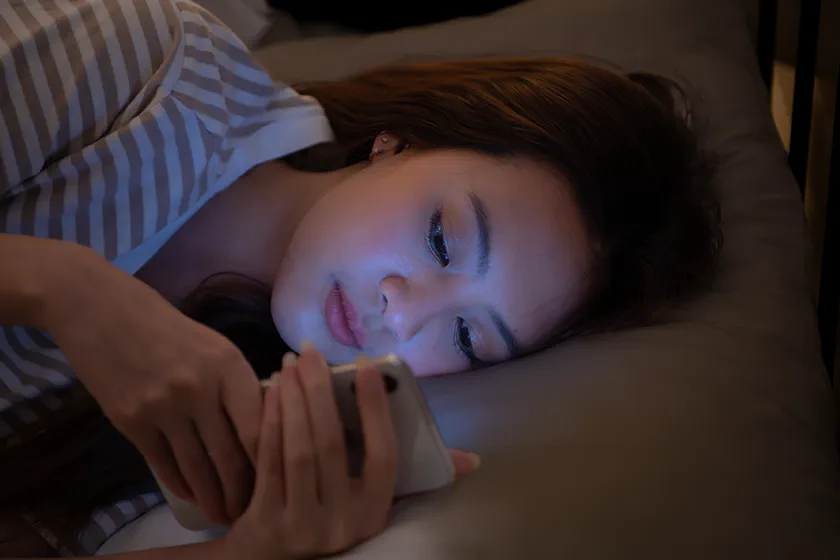How To Keep Your Phone From Ruining Your Sleep

We all know that light can interfere with sleep. Most of us would never even think about going to bed with the lights on.
But it’s not just nighttime light that can affect your sleep. The light that you’re exposed to in the hour before you go to bed can also have a huge impact. If you regularly get into bed, but then find yourself tossing and turning, unable to fall asleep—you might be experiencing the effects of the wrong kind of light before bed.
Why do light levels matter? Are some types of light worse than others? And most importantly, how can you adjust your light exposure to protect your sleep?
Why light impacts sleep
The reason that light is so important is that it affects the brain’s production of a hormone called melatonin.
Melatonin makes you feel tired. As you get closer to bedtime, your melatonin levels should rise. Healthy melatonin levels allow you to fall asleep relatively quickly after you get into bed and turn out the light. If your melatonin levels are low when you get into bed, then you’re likely to find it hard to get to sleep.
Light has a huge impact on melatonin levels. When you’re exposed to bright light, your brain stops making melatonin, and when light levels are lower, your melatonin levels rise. This is because, in a natural environment, you’d only see bright light during the day, when you should be awake. In the evening, as bedtime approaches, you’d only see the dim light of a fire or the moon. Our brains are adapted to respond to this natural scenario, ensuring that your sleep rhythms are aligned to your environment.
Although bright light of any kind can affect melatonin levels, not all light has the same impact. Studies have found that blue light has the strongest impact on melatonin, while orange or red light has a much smaller effect.
How screens affect melatonin
For most people in the modern world, the main source of light exposure is screens—especially our phones. A smartphone screen produces enough light to trick your brain into believing that it’s the middle of the day. Research has found that looking at a phone significantly reduces a person’s melatonin production.
Many people wind down before bed by watching some videos on their phone or scrolling social media. This might feel relaxing, but by exposing you to the bright light of your phone screen, it’s also interfering with your ability to fall asleep. And while phone screens are the most common, any type of screen can have an effect, such as watching a show or movie on your laptop or TV.
How to stop screens from affecting your sleep
To protect your sleep, it’s important to consider the light levels that you’re exposed to before bed.
The best advice is to put your phone away about an hour before bedtime. At that point, go ahead and set any alarms you’ll need for the morning, and then switch to screen-free activities and don’t touch your phone again until morning. This allows your brain to produce enough melatonin, so you’ll have an easier time falling asleep when you turn out the light.
If you find this too challenging, there are ways to help reduce the effect of your phone on your melatonin levels. One way is to turn your screen brightness all the way down to its lowest level. This greatly reduces your exposure to bright light, which helps to protect your melatonin secretion.
You can combine this with a blue-blocking app, which shifts the color of your screen towards the orange and red end of the spectrum. (At this point, many phones have this built in.) Because blue light has the strongest impact on your melatonin, shifting away from blue is helpful. Studies have found that blue-blocking apps do significantly reduce the impact of a screen on melatonin levels, although they don’t eliminate it completely.
Putting your phone away an hour before bedtime—or at least dimming the screen and using a blue light blocker—will help you to fall asleep more quickly and easily when you finally do turn out the light.
Dr. Patricia Shelton, MD, is a medical communicator, neuroscientist, and educator with a passion for making complex medical information accessible. With a Doctor of Medicine and a Neuroscience degree from the University of Washington, she combines deep expertise with exceptional communication skills. Dr. Shelton teaches anatomy and physiology, writes on medical topics, and authored *The Yoga Doctor*. A certified yoga and meditation instructor, she champions a holistic approach to wellness and empowers audiences through clear, engaging health education.



